Inyo County Supervisors Decide on Renewable Energy
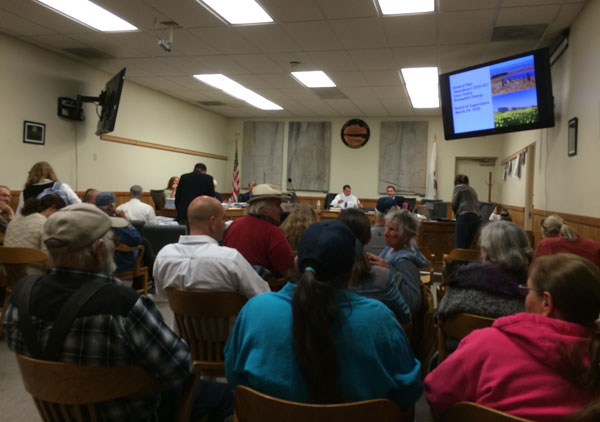
March 24, 2015 - Independence CA - Members of Basin & Range Watch attended the hours-long hearing of the Inyo County Supervisors as they weighed the recommendations by the county planning commission on the Renewable Energy General Plan Amendment (REGPA), a plan which would guide renewable energy development over the Inyo County. The REGPA partially reflects the larger Desert Renewable Energy Conservation Plan (DRECP) being reviewed for the entire California Desert, but has differences that are specific to county concerns. The final decision is important because Inyo is the first county to try to tackle DRECP planning with a general plan set of guidelines. Other counties have indicated they are watching Inyo to see how they might proceed with renewable energy development under the DRECP. County concerns have often differed from state and federal mandates.
Supervisor Matt Kingsley told the packed audience that this REGPA policy was important for Inyo County, but also for other counties. They are watching. He said he talked with a San Bernardino County supervisor who said they were watching what Inyo does. Environmental groups were also watching. He admitted the complexities of the DRECP were often confusing. But this general plan amendment could be tweaked in the future.
To read the resolution and other material from the meeting see: http://www.inyoplanning.org/projects/REGPA.htm
County Planning Commission Process
The county applied for a grant for renewable energy planning as part of the DRECP, and received a grant in July 2013 to undertake a Program Environmental Impact Review (PEIR) under the California Environmental Quality Act (CEQA). Originally wind energy was included as well as solar, but due to large public outcry about bird mortality concerns, wind was recommended to not be a part of county planning efforts.
The 2014 draft of the REGPA PEIR responded to many comments received that indicated a general dislike of utility-scale development, concern over visual resources, the wind energy impact on birds, and any development in the Owens Valley.
The county planning commission said they removed the Centennial Flat Renewable Energy Development Area (REDA) due to popular demand, and made Owens Valley a Study Area. The western county REDAs around Laws, Owens Lake, Rose Valley, and Pearsonville were given a 250 MW cap.
A Community-scale solar element was added.
Finally, the REDAs were renamed SEDAs (Solar Energy Development Areas) since wind energy was eliminated.
The current SEDAs up for discussion and approval by the board of supervisors included: Laws, Owens Lake, Rose Valley (near Olancha), Pearsonville, Trona, Sandy Valley, Charleston View, and Chicago Valley.
The planning commission said all meetings were very well-attended.
Today the Final PEIR was presented and the slight modifications were shown. The "Distributed Generation" label of 20 MW or less projects, was changed to "Commercial Scale Solar Energy Facility."
A category was added of "Community Solar Energy," equaling 6 MW or less, or 36 acres. We think this is the right direction to go towards.
Overriding Considerations
For followers of the large-scale solar projects in other parts of California over the last 6 years, this phrase conjures up visions of streamlining and obfuscation of significant impacts in favor of approving developments that harm the environment with no possible mitigation. Basin & Range Watch has followed several of these utility-scale projects where overriding considerations were used to approve damaging projects in sensitive environments.
The planning commission said the overriding considerations included:
--Lower emissions from fossil fuel use
--Improved regional air quality
--Helps meet the California's RPS
--Potential economic benefits
--Helps support re-purposing of disturbed lands
We were only given 3 minutes to comment so could not respond to all of these during the public comment period, but to us it is obvious the California Renewable Portfolio Standard, which Governor Brown said in a speech recently he wants to raise to 50% by 2030, could be filled largely by distributed generation policies that encourage rooftop and parking lot solar systems and energy efficiency. We are encouraged that the county hopes to develop disturbed lands first, before living ecosystems, but the low-hanging fruit of DG should be highest priority. "Potential" economic benefits might be erased by lessened tourist dollars as tourists do not come to Inyo County to see massive industrial complexes, but rather wild open valleys and mountain ranges with far vistas.
Removed
The Planning Commission removed a section that asked for compensation for military lands or lands with sensitive species that could potentially be developed for renewable energy but would not be because of these other factors. This was universally disliked.
Alternatives
A popular alternative, and one that many environmental groups pushed for, was a 20 MW cap on projects in the county. A developer could apply for a general plan amendment if they wanted a larger project.
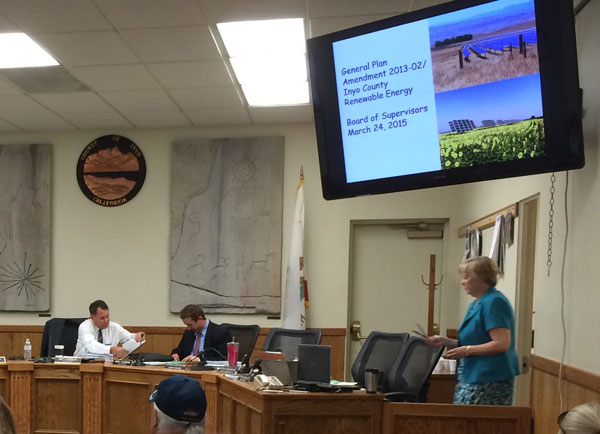
Summary of Public Comments Received by the Planning Commission in its Review
As part of the California Environmental Quality Act (CEQA) reviews, the Planning Commission sought and responded to public comments of the draft REGPA. These were summarized during the hearing for the supervisors to hear. Will they listen?
65 comments were received during the draft EIR process, and 9 comments to the Planning Commission on recommendations to how to certify and adopt by the supervisors.
The public asked to not streamline project review, and prohibit renewable energy in Areas of Critical Environmental Concern (ACECs) and National Conservation Lands. The county itself was concerned with the loss of mineral access.
Commenters asked to remove the Owens Lake SEDA due to bird and archaeological concerns. The Centennial Flat SEDA had been removed but some "leftover" areas were still needing to be eliminated for consideration along I-90.
Most comments asked to remove Charleston View as a SEDA or shrink it. One man, present at the hearing, had commented that the cap should be raised to 500 MW there; he lived in Las Vegas and represented the Wiley Trust that owned 10,000 acres there.
Other comments explained that there were Mojave ground squirrel connectivity concerns in the Rose Valley SEDA in southern Owens Valley area south of Olancha.
Many comments asked to keep solar energy to disturbed areas.
Comments also asked to remove the Chicago Valley SEDA and Trona SEDA (the latter due to Mojave ground squirrel presence, lack of transmission, and groundwater issues).
The Owens Valley Study Area includes nearly the entire valley from Bishop to Lone Pine, and many commenters requested this be removed or limited to Community Scale Solar on old mine sites, land fills, and along the Los Angeles Aqueduct; disturbed land options were popular.
Disturbed lands were also requested to be used for the Pearsonville SEDA.
Some comments on the 20 MW cap were that multiple inter-tie connections would be needed.
Planning Commission Recommendations to the Supervisors
--Photovoltaic only
--20 MW cap (the public prefers this); a distance requirement should be added to separate projects
--Modify the Rose Valley and Pearsonville SEDAs to match the DRECP
--Eliminate Chicago Valley SEDA and Charleston View SEDA
--Remove support for Development Focus Areas and Variance lands identified in the DRECP
--Avoid ACECs and NLCS lands
--Additional recommendations were to add a policy that the county does not support new transmission lines built in or through Inyo County, above what is needed for SEDAs within their MW caps. We support this.
--Impacts to Death Valley National Park and the Old Spanish Historic Trail could be minimized with screens, setbacks, and "lowering the angle of PV panels in projects so they would not be as visible." This last recommendation is somewhat absurd since solar companies must use a very accurate angle to catch the sunlight, and hikers on the various mountain peaks would still look down onto vast arrays of PV solar fields so visual impacts would not be avoided.
Some Controversies the Planning Commission Discussed
The 20 MW cap was controversial, and although preferred by the public, the planning commission explained that in some cases it might hinder using disturbed land: the old Coso hay ranch, for instance, could take half of the western Inyo County SEDAs megawatts, but a 20 MW cap would hinder this.
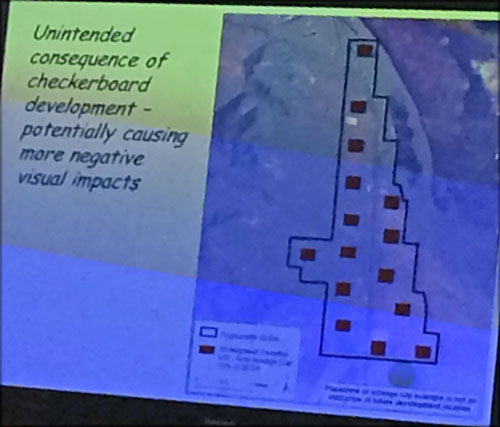
^Pearsonville SEDA with 20 MW cap showing possible checkerboard of the projects.
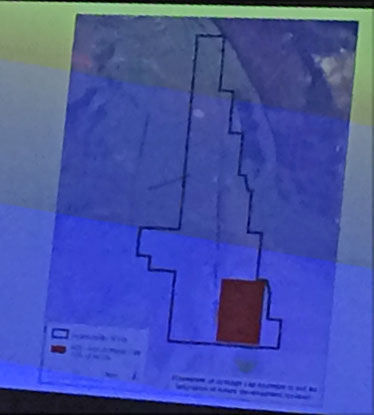
^Pearsonville SEDA with no cap, allowing a large project.
The Charleston View SEDA was very controversial-- most small land owners wanted it eliminated, and one large land owner representative wanted it increased. The Old Spanish Trail runs through the area, and has been well analyzed during the Hidden Hills solar energy project hearing conducted by the CEC. The findings were that significant impacts would harm the viewshed and historic character of the area.
The planning commission tried to make an argument that if the Charleston View SEDA was eliminated, then the area could see even greater groundwater pumping if complete build-out of housing units was followed by zoning instead. A 20 MW cap could reduce visual concerns for the Old Spanish Historic Trail and groundwater concerns. The planning commission argued present zoning could support 4,000 housing units with a higher water use. PV projects supposedly use 2 - 10 acre-feet of water per year (AFY), and Hidden Hills solar thermal power tower wanted 140 AFY. The argument goes that the average Inyo County household has 2 persons, and the household uses 0.20 - 0.26 AFY of water. This would equal 840 - 1100 AFY if full build-out occurred in Charleston View with maximum housing. We think this is a poor argument since full build-out is theoretical and may not happen due to groundwater concerns in neighboring Nevada, where Pahrump is contiguous with Charleston View in the same basin. It has also been the case that Ivanpah Solar Electric Generating System and Desert Sunlight Solar Farm have both asked for increases in groundwater use and pumping after approval, as they see that more water is needed, especially for dust control.
A representative of the Mary Wiley Trust (who lived in Las Vegas, NV), spoke against the 20 MW cap. The trust owned 10,000 acres in the Charleston View area. He quoted BrightSource claims that groundwater pumping for proposed solar projects in the area would have minimal impact.
Big Pine Paiute Tribe Comments
A representative for the tribe told the board they wanted the county to emphasize local community-scale solar, and eliminate the SEDAs. Even for local community-scale solar projects a CEQA analysis should be done. They said tribal consultation with the county has been difficult.
Public Comments
A resident of Charleston View said most people in the community supported the Planning Commission's recommendations.
Several environmental groups were present and they made an abrupt about-face on their prior support of the 20 MW cap. They each made comments that they now withdrew their support for the cap, saying it would cause other problems, and now were not opposed to large sized utility-scale solar projects in Inyo County. They said no cap would allow for more flexibility in using disturbed lands. "Larger projects were needed to fight climate change," one environmental group said. One environmental group recommended having a 20 MW solar pilot project on Owens Lake to see how photovoltaic arrays would impacts birds. Environmental groups making comments included The Wilderness Society, Friends of the Inyo, the Amargosa Conservancy, and Defenders of Wildlife.
Inyo County residents universally made comments about supporting rooftop solar first, promoting ecotourism, and not allowing industrial solar in Owens Valley. many wanted no SEDA in Charleston View.
Amy Noel of the Tecopa Hot Springs Resort wanted a place for urban dwellers to come, free of development. She said the last two years were the best for ecotourism.
The manager of the Tecopa Conservancy asked the county to move to home-based solar. The audience applauded loudly.
On the "unintended consequences" mentioned by planners of having a 20 MW cap, some residents commented that a feared checkerboard of little projects would probably never come to pass due to the activists in this room and responsiveness of the board. Another said a 20 MW cap would send an important message to the state and and feds, or not supporting large-scale industrial solar. "We want to move to solar on houses and local transmission."
Discussion of the Rose Valley SEDA centered around Defenders of Wildlife comments on Mojave ground squirrel and the old hay farm that they said could accommodate 1,000 acres of solar on disturbed land. The Mojave ground squirrel connectivity along the west side of Hwy 395 could be kept open if the SEDA was limited to the land east of the highway, which had fallow farmland.
Coso Generating Facility made a comment that they did not support the 20 MW cap, and worked to conserve the Mojave ground squirrel. They owned the old hay farm in Rose Valley. They proposed to connect their Dixie transmission line from western Nevada with NV Energy to the Bishop substation with an upgrade, in an agreement with the California Independent System Operator.
Basin & Range Watch made a public comment supporting the 20 MW cap, saying this was the right direction, but even better the county should go wholly for DG and rooftop solar and keep the beautiful viewscapes and scenery of the Inyo County wildlands intact. Tourism is very important for the county and this should not be sacrificed when better alternatives exist for renewable energy in the built environment. We also opposed the Charleston View SEDA, asking for it to be removed (we also opposed the other SEDAs but did not have time during the three minute comment period; no ecosystems need be developed with large-scale renewable energy when alternatives such as the CEESP exist).
The County Board Discusses the Plan: A Top-Down Approach
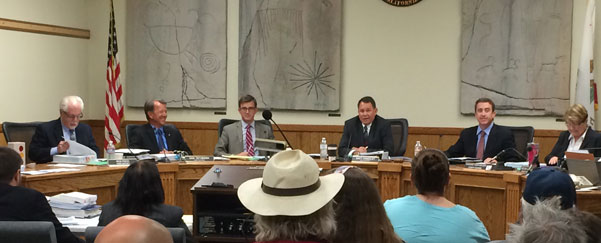
Supervisor Jeff Griffiths recalled how 5 years ago when this planning process was just getting started, the Clinton Foundation was seeing a sea of solar panels from Owens Lake to Laws, 5,000 MW. He said there were limits to land use planning by local authority, when only 2% of the county is in private hands. The rest is federal and Los Angeles Department of Water and Power. The state planners in Sacramento see our area as a great resource to increase renewable energy, he said. Some development is inevitable he added. He indicated climate change was more important than other concerns. The state was demanding a certain amount of solar development, so it was not realistic to have all rooftop and parking lot solar, even though he said that made sense.
Supervisor Mark Tillemans said this plan amendment has to be acceptable to our state and federal partners; "we have to play along in terms of global warming." he said he was glad to see the 20 MW cap rescinded in comments (ignoring how the majority of the audience supported the cap, and only a few environmental groups and large land-owners wanted it). he said we must let the state and federal government know we are doing our part, and that "we are not a NIMBY county."
Supervisor Dan Totheroh said the Planning Commission had the best of intentions, but changes were needed. He had concerns with the 20 MW cap.
Supervisor Rick Pucci said a broader general plan would be better, and he changed his mind on the 20 MW cap -- "smaller may not be better."
Supervisor Matt Kingsley summed up that they would use some of the Planning Commission's recommendations. He said the California Energy Commission had funded our planning effort, but "we have no strings attached." A lot of the decisions are being made for us by the state and federal agencies, he said, and other counties are watching. He wanted caps on acreages within each SEDA but not caps on megawatts. Solar projects should mow desert surfaces and not scrape them to maintain brush, Kingsley recommended. He supported the PV-only policy, and he liked the community-scale development kept at 35 acres; it was a great goal to have this be community-owned, although he did not know how to achieve that yet.
Kingsley asked that a setback be made for the Laws SEDA from East Line Street. The SEDAs would give future property-owners guidance as to where solar projects might be placed.
As for the Owens Lake SEDA, Kingsley said there are acres of gravel out there that solar could be put on (the gravel is actually mitigation for dust, placed on top of the dry playa in parts of the lake-bed by DWP programs). There is a bird concern, and in the DRECP the Owens Lake is made an ACEC. It could have a 250 MW cap, use disturbed land first within SEDAs.
The supervisors agreed to use the recommendations and maps provided by Defenders of Wildlife for the Rose Valley SEDA, keeping Mojave ground squirrel habitat on public lands west of Hwy 395.
A reduced boundary was accepted for the Pearsonville SEDA.
The Owens Valley Study Area was kept, and potential policies for it that were discussed today could apply, Kingsley said. A CEC grant was being pursued to study it more. one idea was to limit solar to community-scale.
The Trona SEDA was shrunk, following Defenders of Wildlife maps that saved some Mojave ground squirrel habitat and kept development to around the golf course and airport. Kingsley thought much of the area was disturbed so appropriate for renewable energy (We think otherwise, the area has prime desert tortoise habitat and rich diverse wildflower displays.)
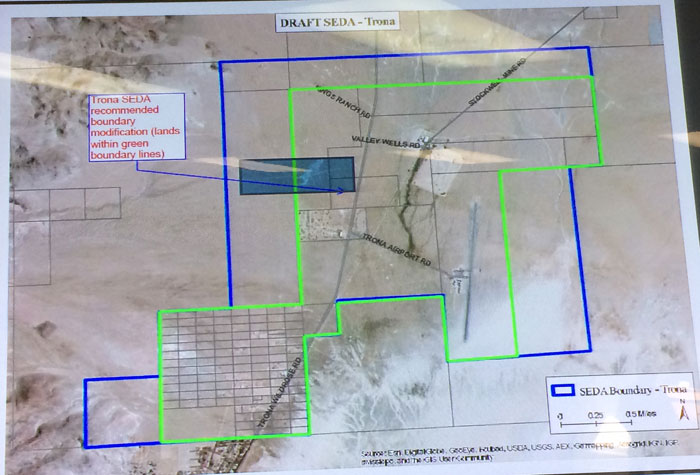
^Draft Trona SEDA in blue outline, with Defenders of Wildlife proposed reduction in green.
The Chicago Valley SEDA was removed.
The Sandy Valley SEDA was supported, Griffiths quipping that solar would be better than the "turf farms" there now. (We disagree-- the area has some alfalfa farms that provide economic benefit, they are not 'turf farms.' private residences, ranches, and a horse rescue facility also exist in the California side of Sandy Valley. Were these residents consulted? In addition, the Sandy Valley has some of the most unique and undisturbed examples of mesquite-sacaton grass-saltbush basin plant communities we have seen in the Mojave Desert.) Most supervisors admitted they had never been there or only visited the area recently.
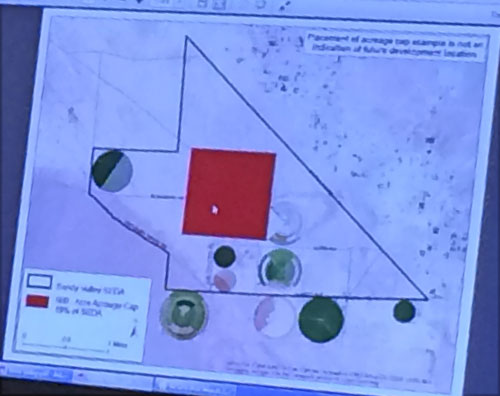
^Sandy Valley SESA with large development allowance, shown in red to show relative size (geographic area not yet determined).
The Charleston View SEDA was kept, and a western part removed as it was recommended to be a National Conservation Land in the DRECP. But solar development could be allowed to fill 2,500 acres with a 400 MW cap -- an enormous development shadow for this rural area. The supervisors argued that removing the SEDA would limit their influence in the case of the Hidden Hills solar power tower project was in hiatus; BrightSource was probably trying to shop the project to another company and it could come back. The county would recommend PV only, on disturbed land, and try to avoid the Old Spanish Historic Trail. Buffers, screens and other mitigation measures recommended during the Hidden Hills solar case could be used. (Although the trail is splayed into several branches through this area, and the entire viewshed is crucial to keeping its historic character.) The angle of tilt of PV panels could be lowered to ease visual impacts, said one supervisor (although solar engineers would undoubtedly balk at this since the angle of PV panels is precisely determined to maximize capture of solar radiation).
As for groundwater pumping concerns in the Charleston View SEDA, a hydrologist explained that Pahrump has been in overdraft since the 1950s. Some supervisors said if each landowner could sink a well, perhaps large solar projects would be better. The Charleston View area is not in adjudication -- meaning in a state lawsuit where every individual is basically in the lawsuit and water rations are in effect. The hydrologist explained that under new California water laws Charleston View would probably be a low priority for a water plan. Mitigation measures for large solar projects could be to retire water rights (although the Bureau of Land management had sent written comments during the Hidden Hills solar case to CEC saying only active water rights would make any difference).
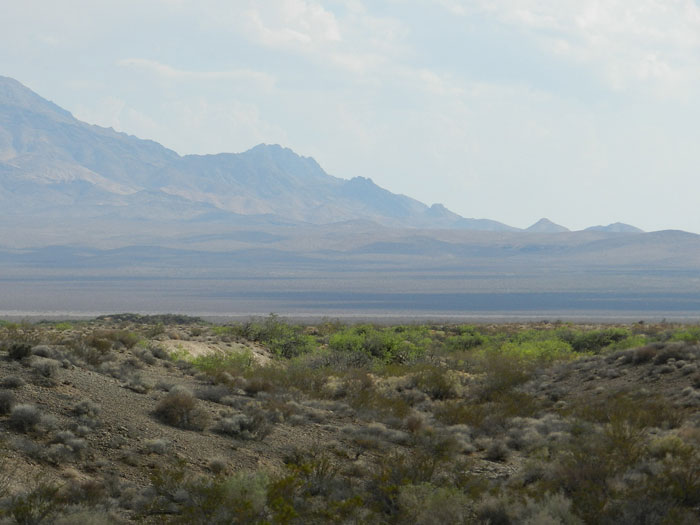
^Charleston View SEDA, from Stump Springs ACEC.
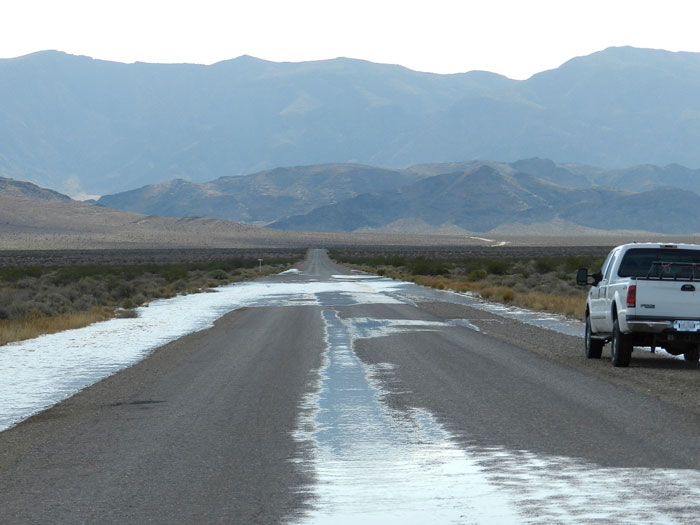
^Charleston View SEDA, a summer rainstorm floods the road.
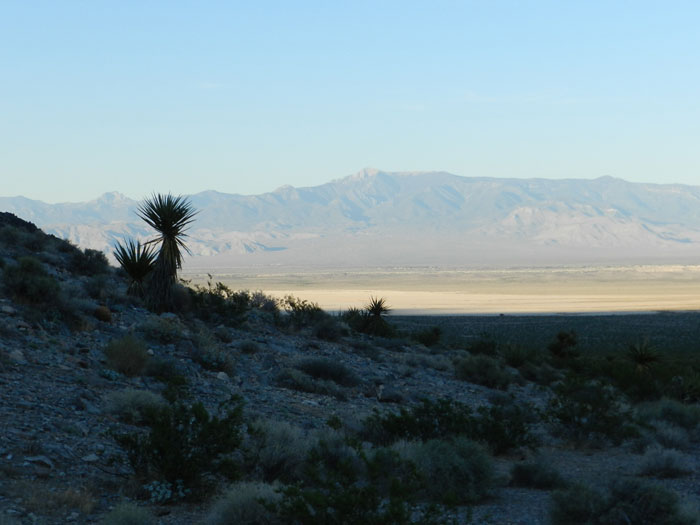
^Charleston View SEDA, Mojave yucca (Yucca schidigera) overlooking the basin towards Mt. Charleston in the Spring Range (Nevada).
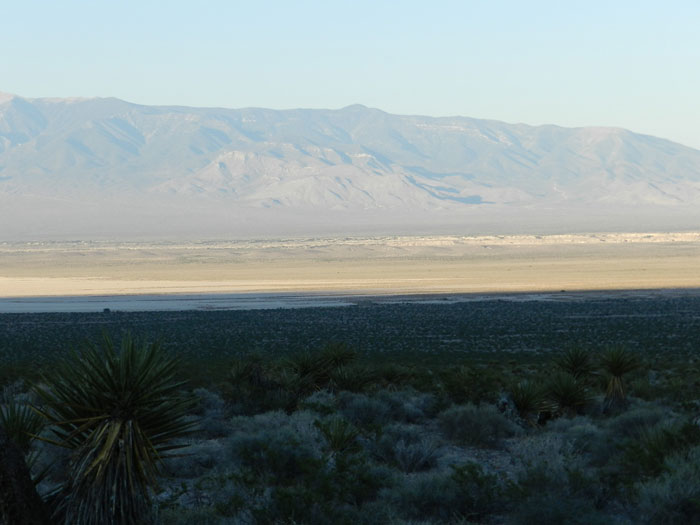
^Charleston View sunset, standing in Inyo County looking eastward with the Spring Range in the distance.
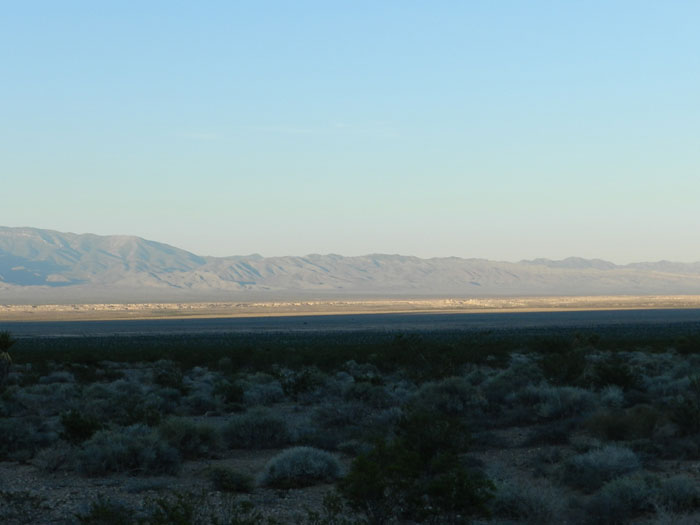
^Wide open spaces of Charleston View SEDA.
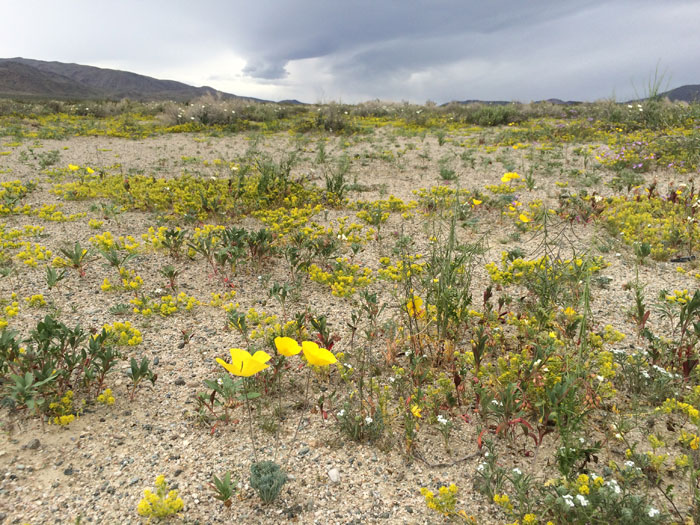
^Trona SEDA this March. A good wildflower show was present right in the reduced acreage map development zone. This area is not all disturbed land but much is high quality desert.

^Trona SEDA. Brown-eyed evening primrose (Chylismia claviformis).
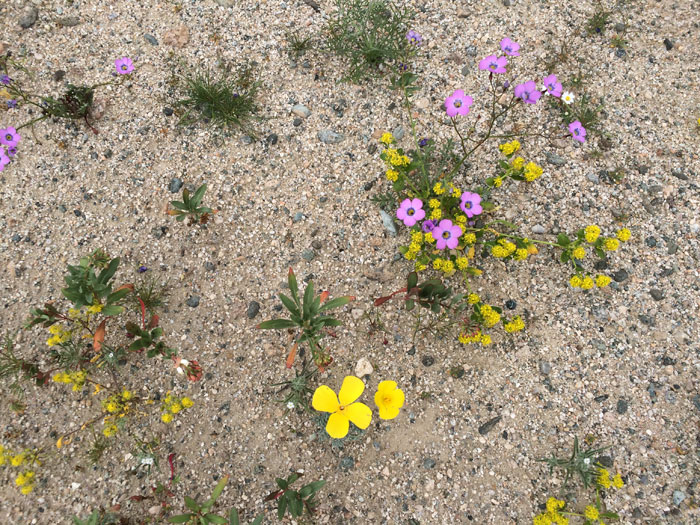
^Trona SEDA. Yellow pepper-grass (Lepidium flavum), desert gold poppy (Eschscholzia glyptosperma), and broad-flowered gilia (Gilia latiflora).

^Trona SEDA. Yellow pepper-grass, poppy, and Booth's evening primrose (Eremothera boothii).
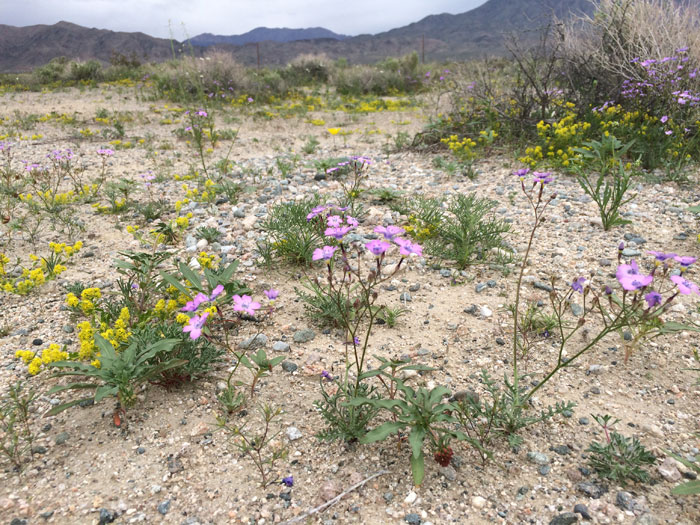
^Trona SEDA. Yellow pepper-grass and broad-flowered gilia.
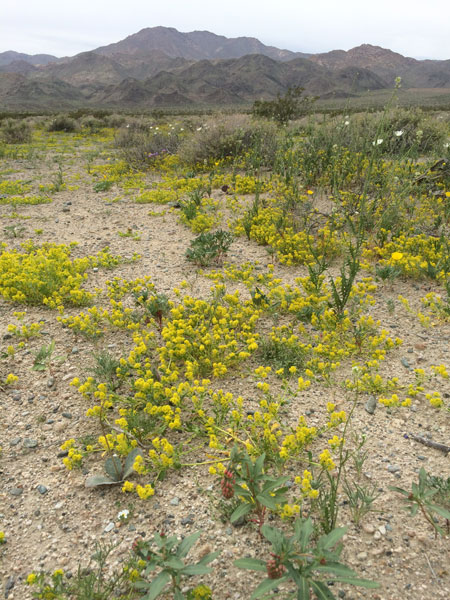
^Trona SEDA. Yellow pepper-grass.
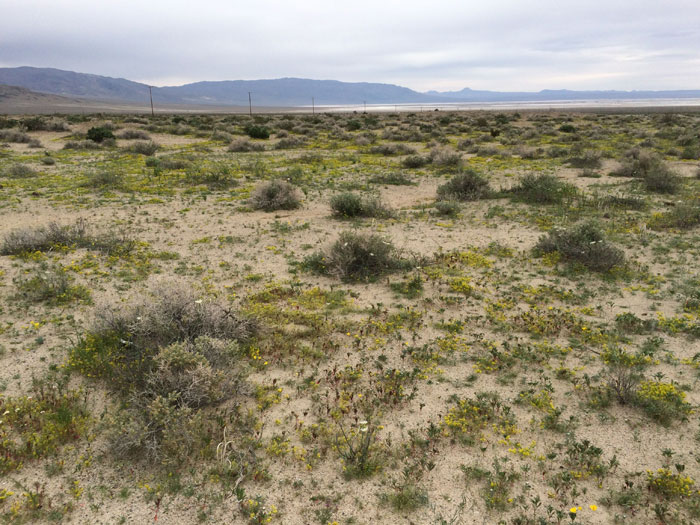
^Trona SEDA, looking southeast towards Searles Lake. This would be opened for solar development in the REGPA. Acres of yellow pepper-grass were blooming this week.
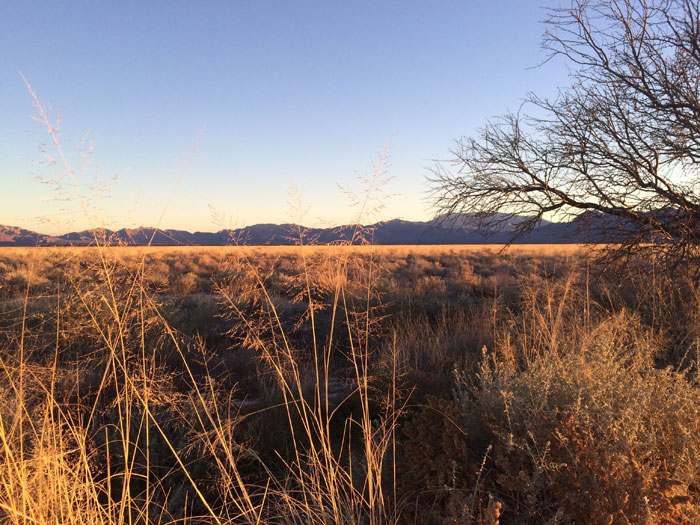
^Sandy Valley SEDA in California, with Alkali sacaton (Sporobolus airoides) and Honey mesquite (Prosopis glandulosa), with some saltbush (Atriplex spp.).

^Dense healthy stands of alkali sacaton bunchgrasses.
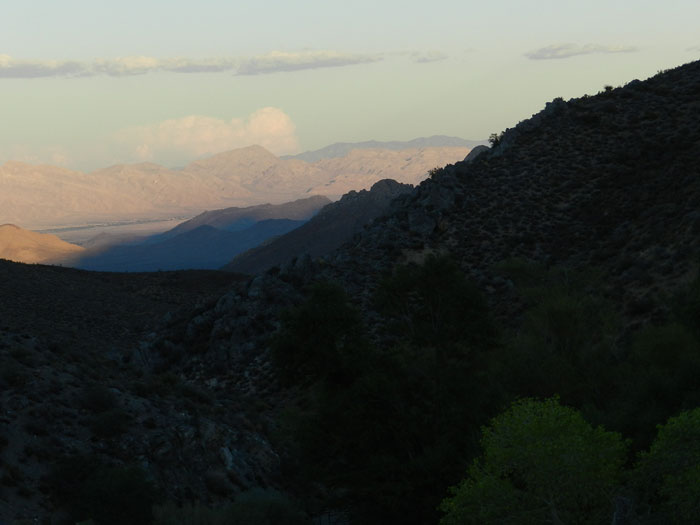
^Sandy Valley view from the Kingston Range.
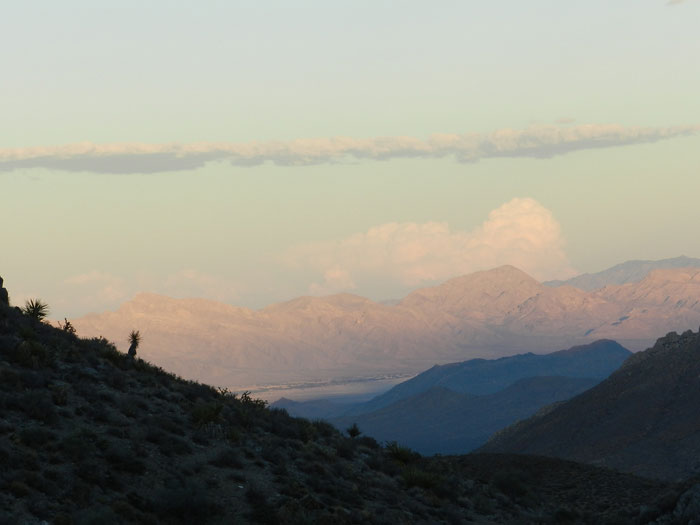
^Sunset over Sandy Valley as seen from the Kingston Range. Mesquite thickets can be seen in the basin.
